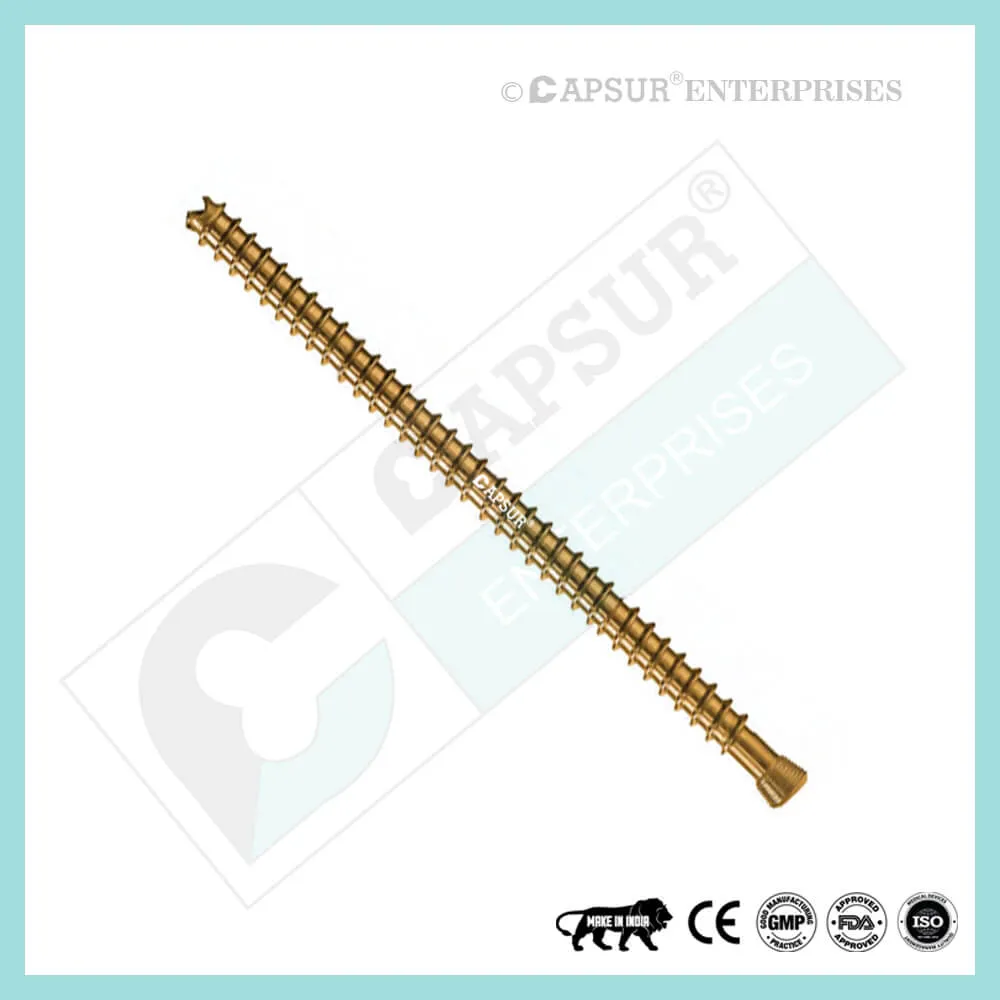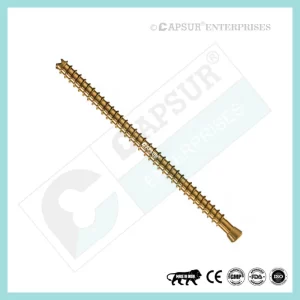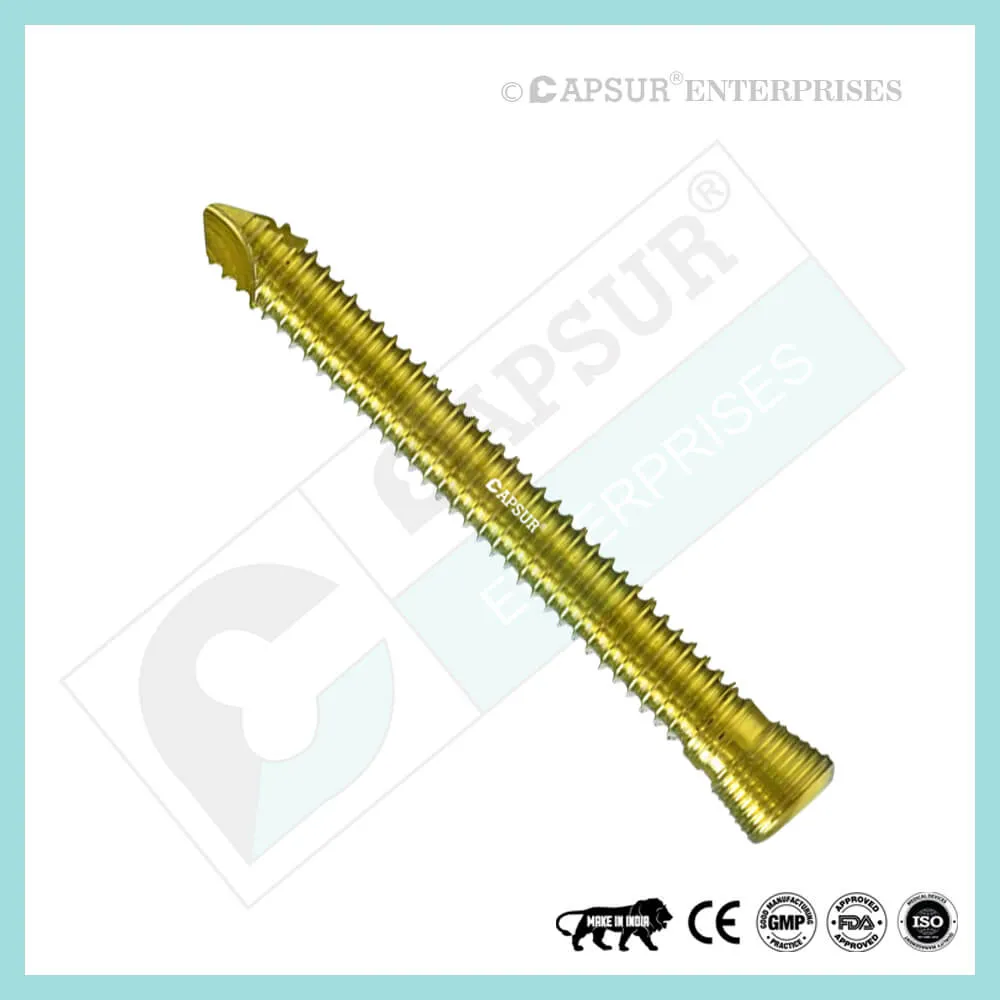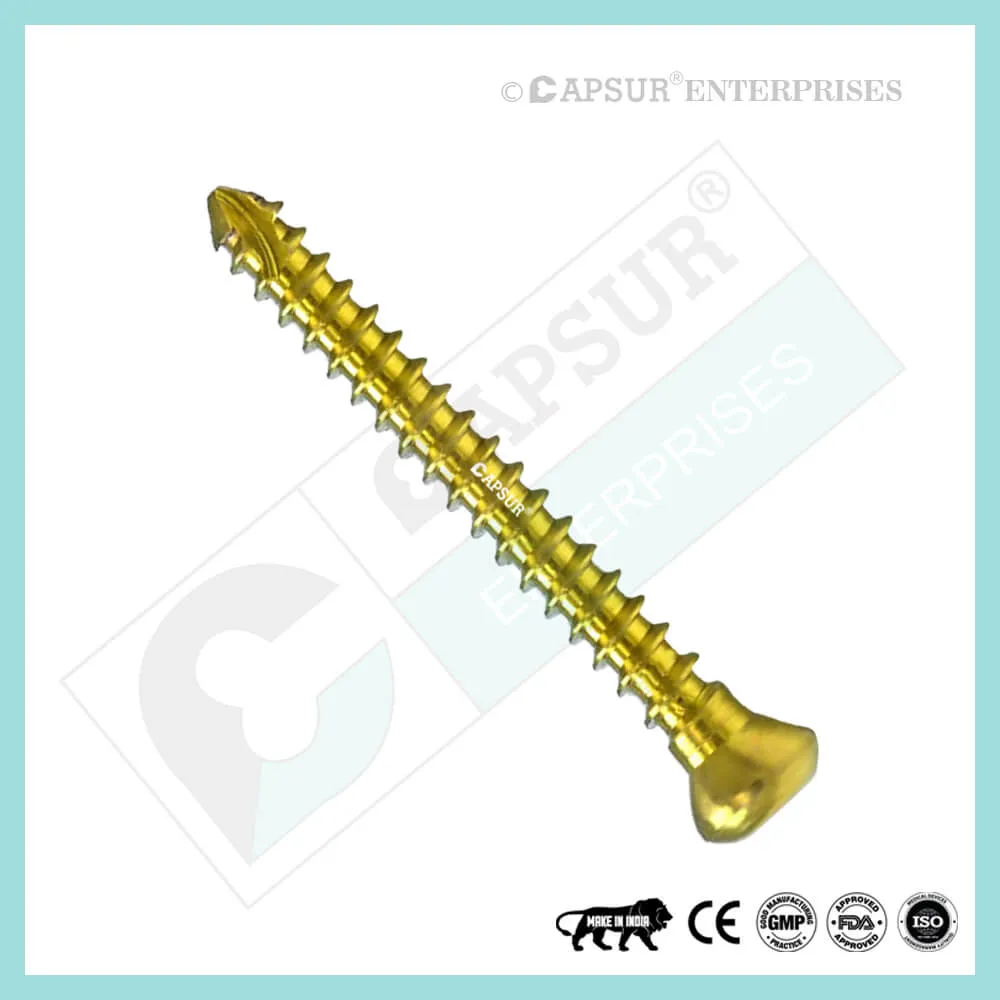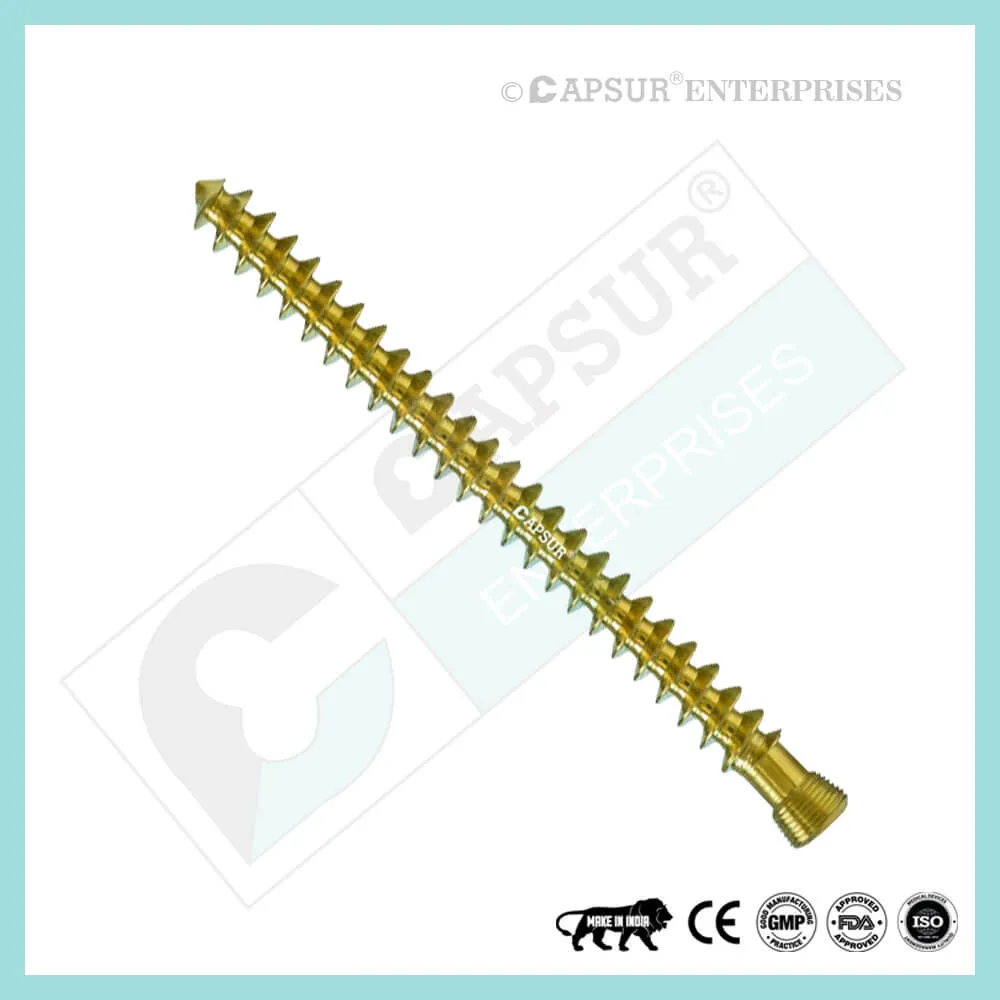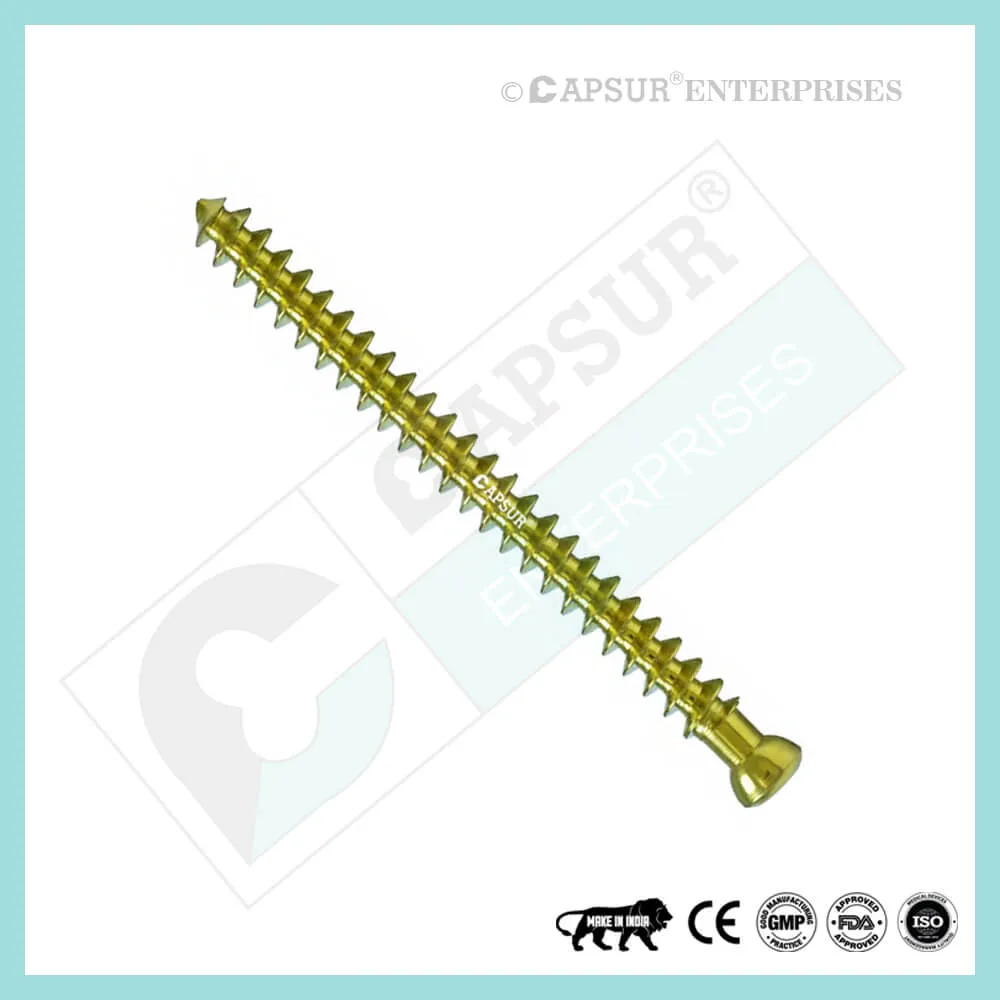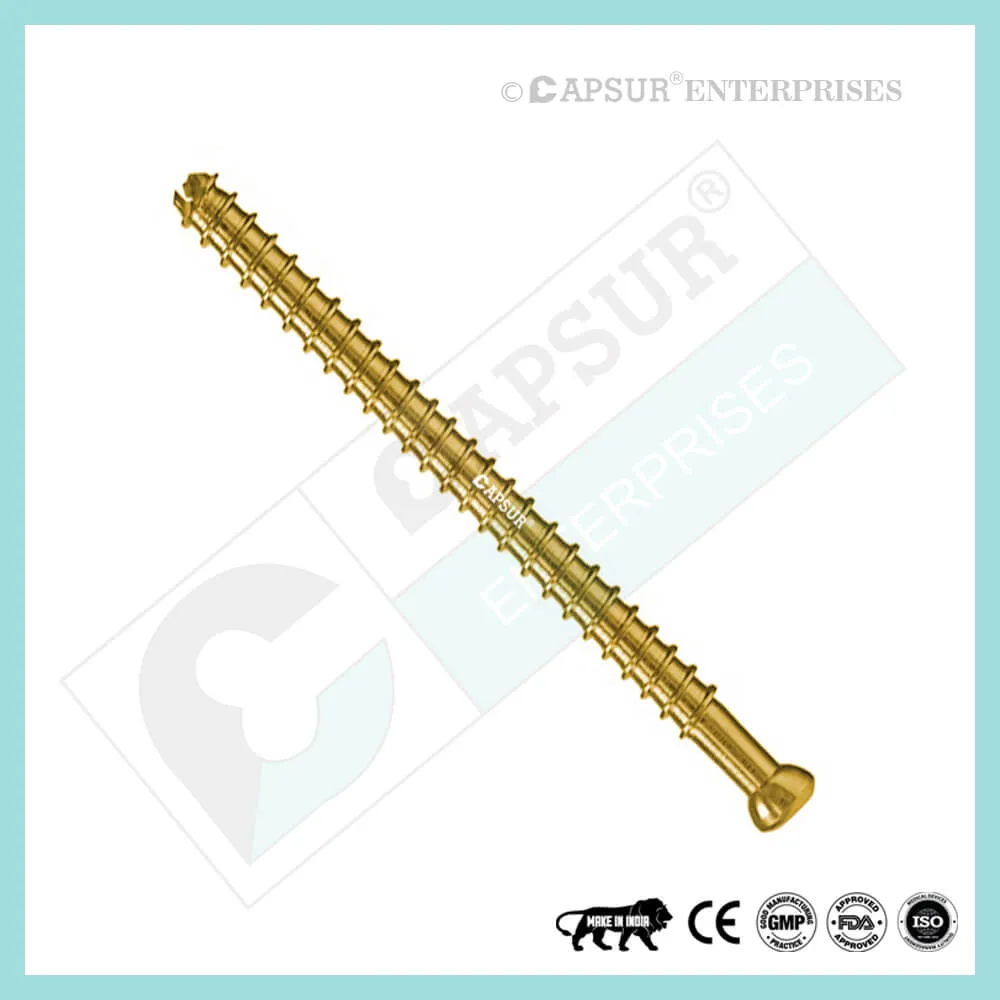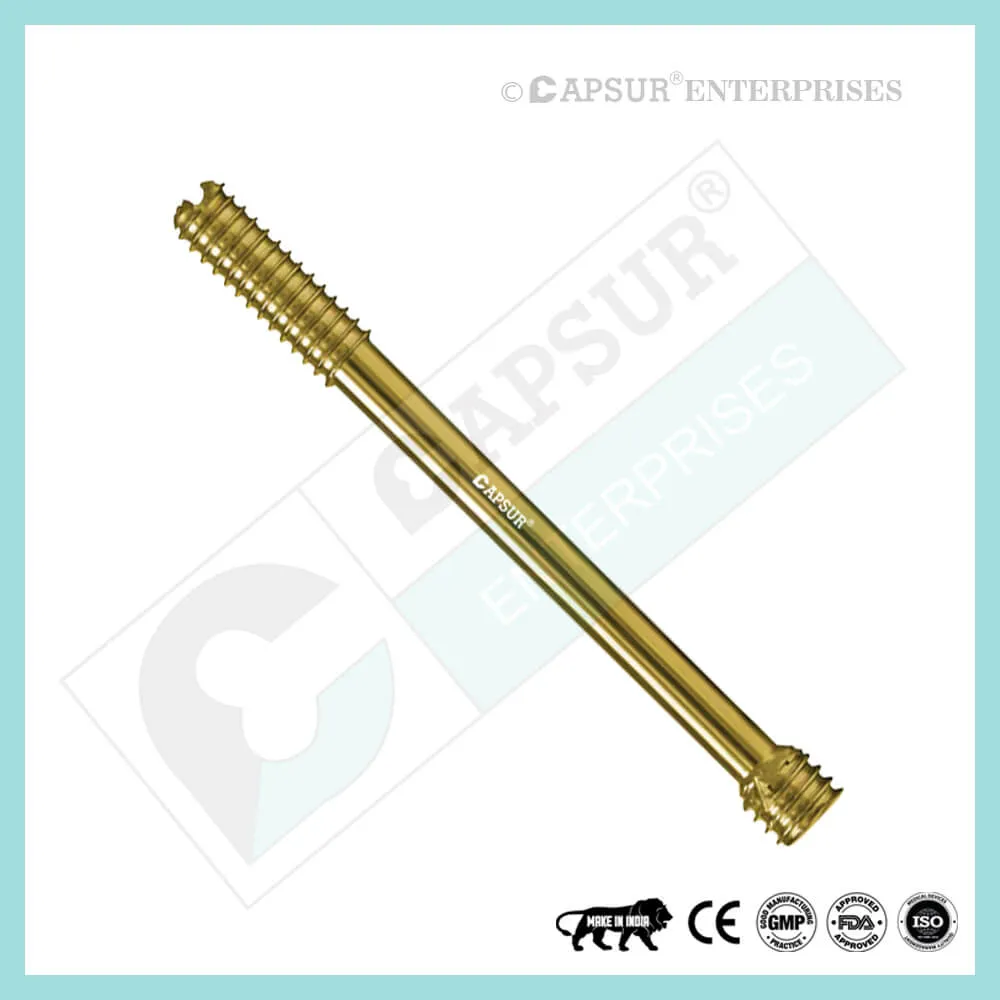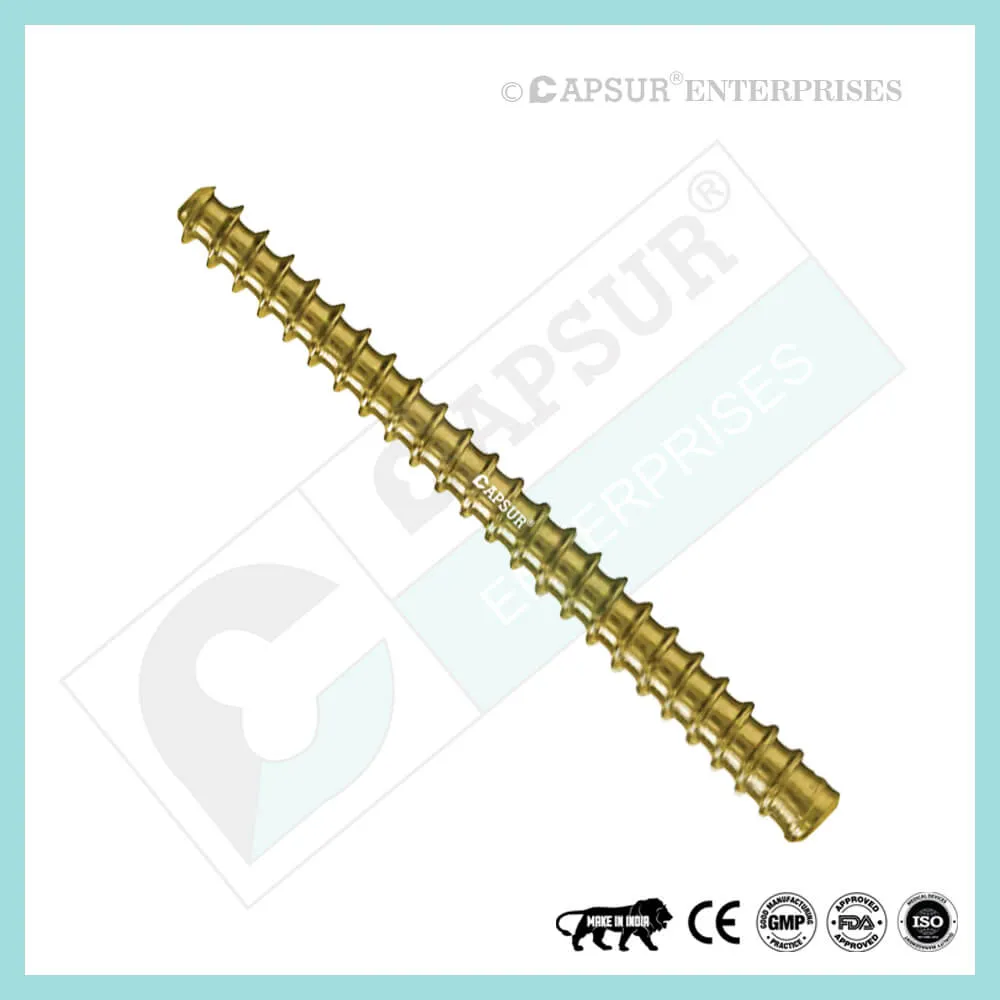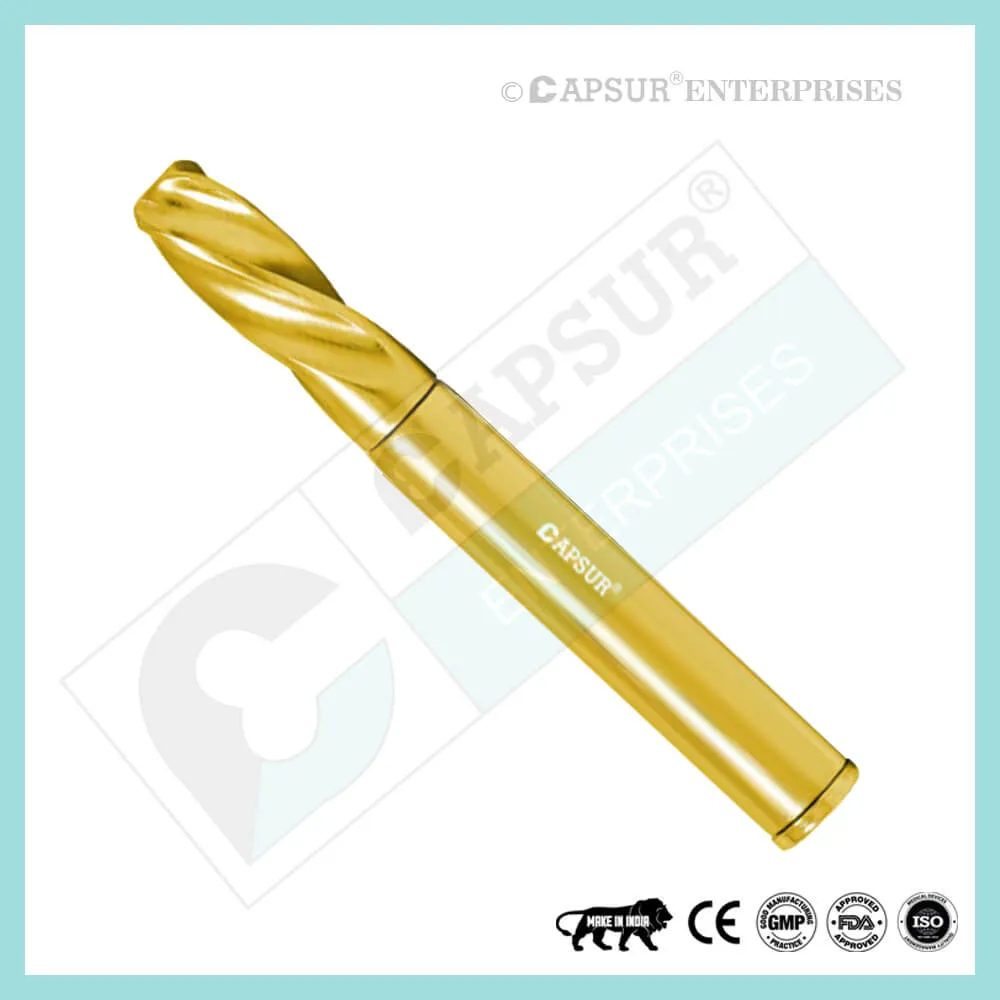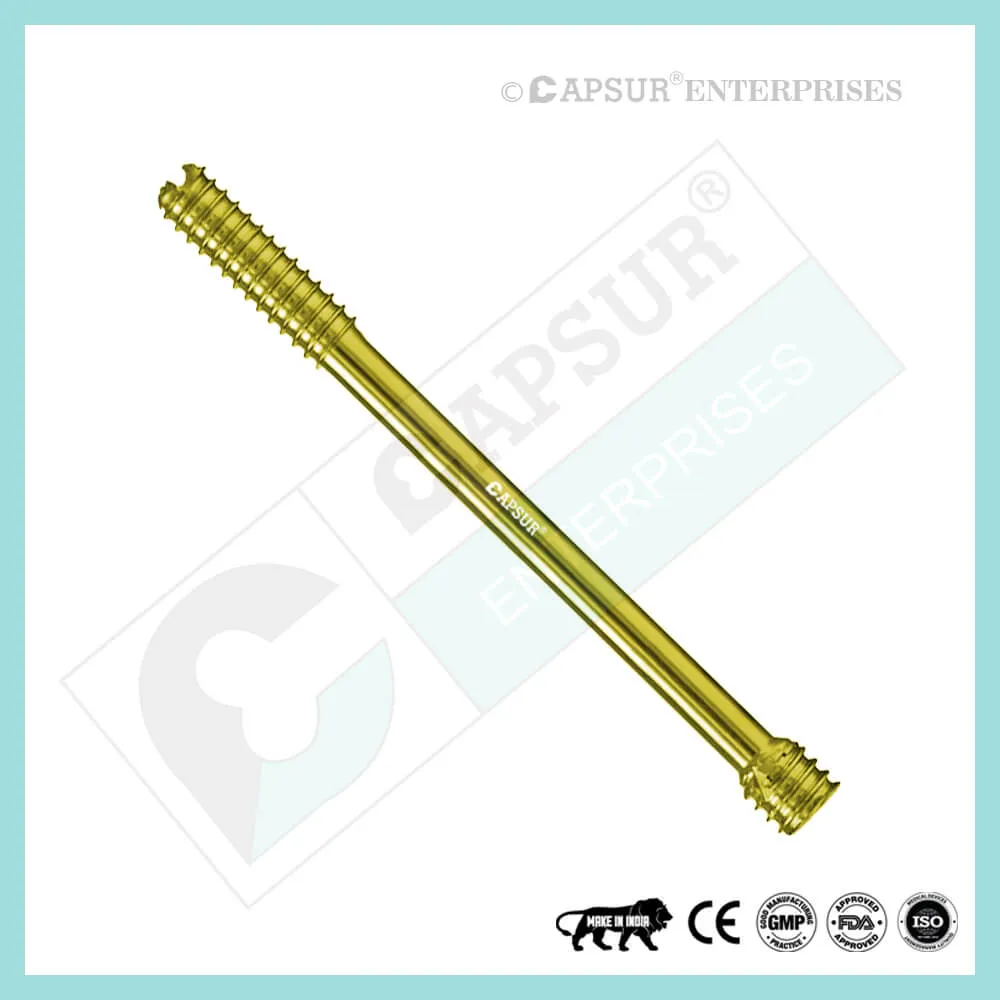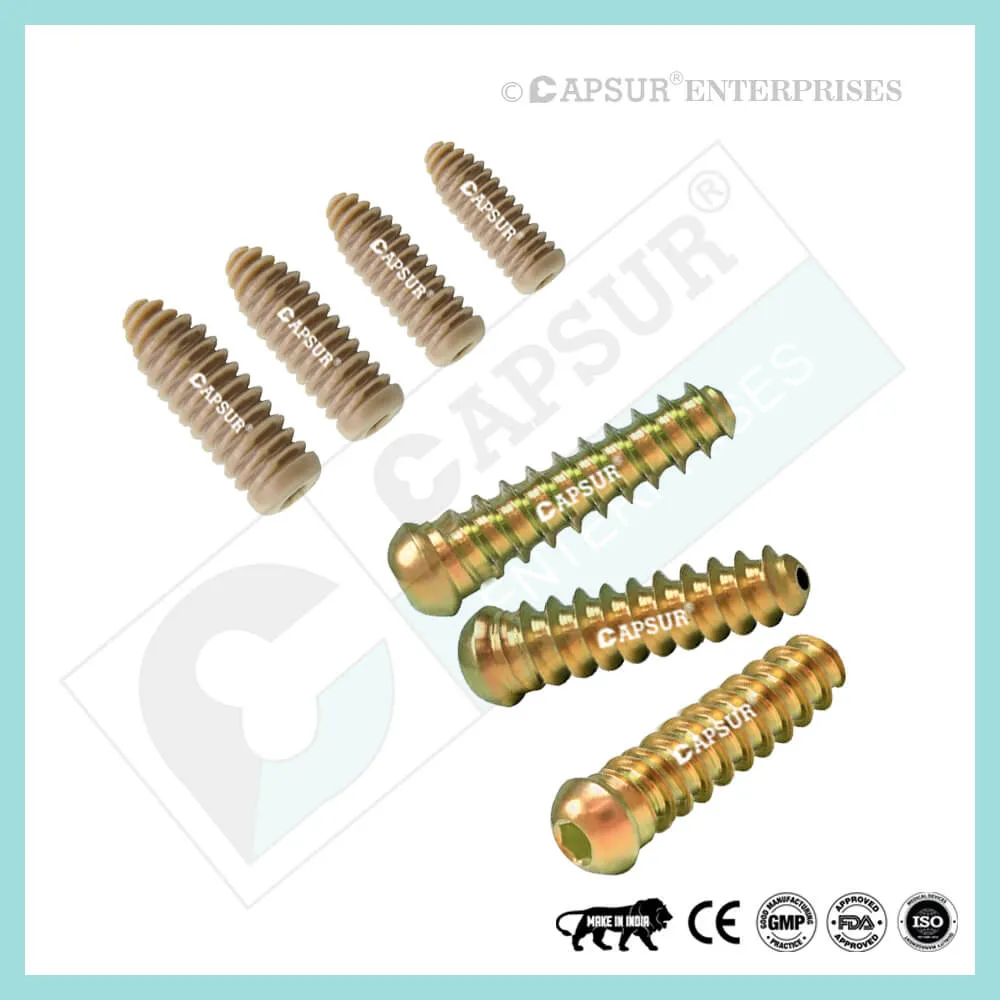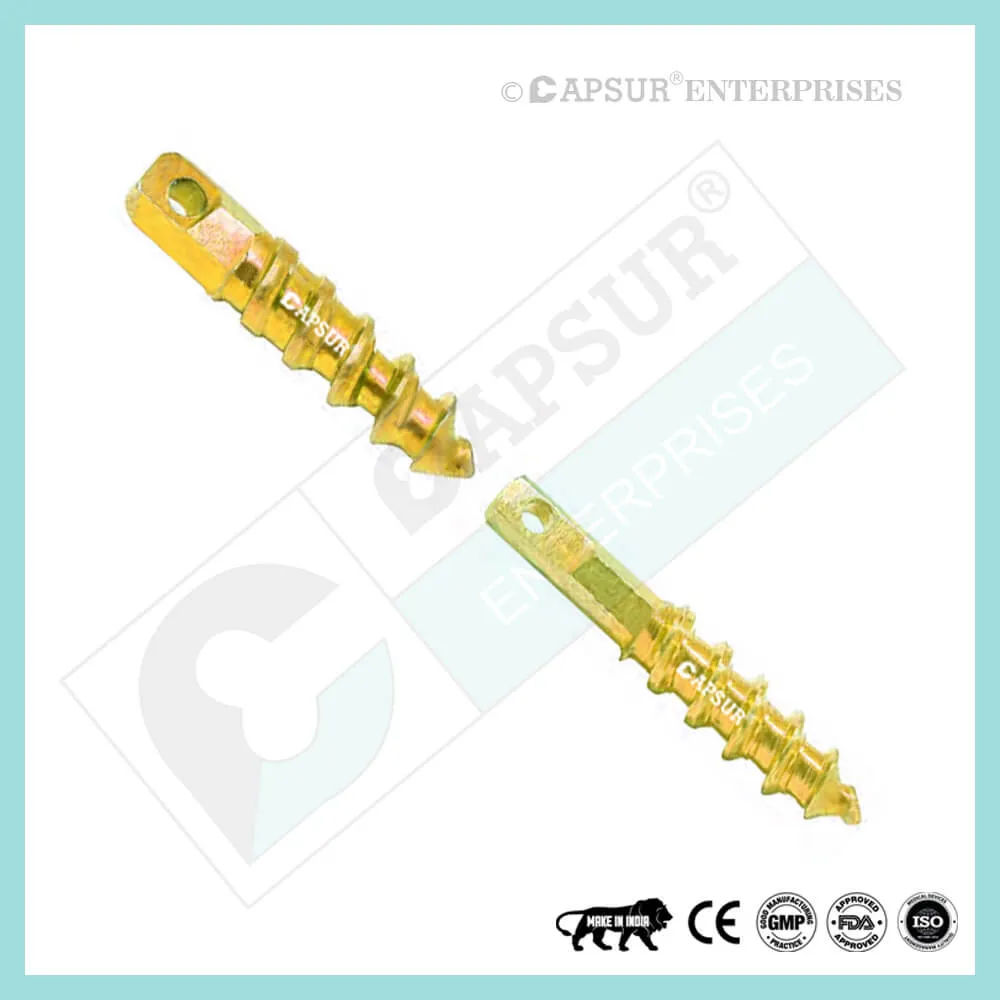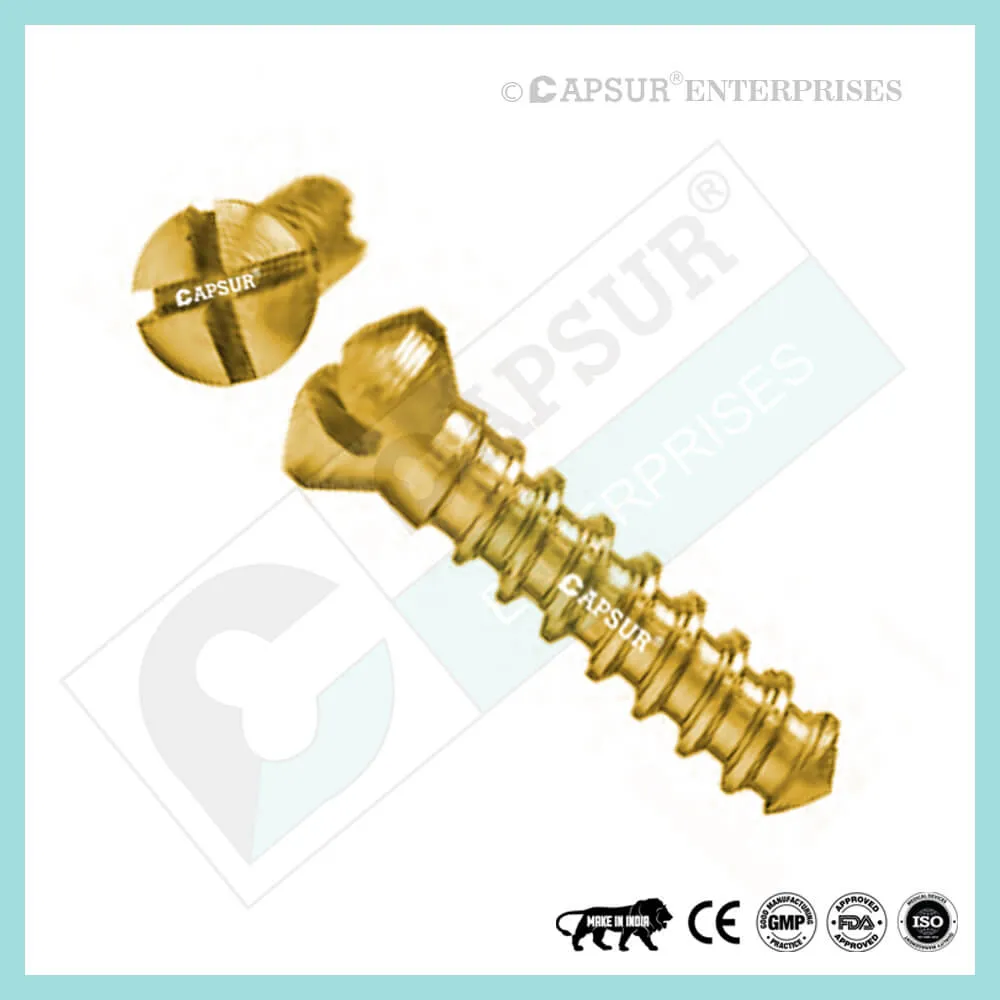Model No: 124433-A12
Description: Lorem Ipsum is not simply random text.
- SUPERIOR QUALITY
- AFFORDABLE PRICING
- TIMELY SHIPMENT
- CUSTOMER SATISFACTION
Specification for 4 mm Locking Cannulated Screws
4 mm Locking Cannulated Screw available lengths are 10mm, 12mm, 14mm, 16mm, 18mm, 20mm, 22mm, 24mm, 26mm, 28mm, 30mm, 32mm, 34mm, 36mm, 38mm, 40mm, 45mm, and 50mm
The thread on a 4 mm locking cannulated screw is cancellous. Deep cutting threads with a large pitch are used in cancellous thread profiles to increase pullout resistance. Additionally, a large pitch speeds up screw insertion and removal.
Pure Titanium and SS 316L are used to create the 4 mm Locking Cannulated Screw.
This screw will be produced on demand in any additional length sizes.
1.25 mm diameter guide wires, both threaded and unthreaded, can be inserted into the cannulated shaft.
For greater interfragmentary compression, choosing thread lengths that fit the farthest bone fragment best is recommended.
Screw removal is aided by reverse-cutting flutes.
Soft tissue irritation is less likely with a low-profile head.
Self-tapping screw, that is. Self-Tapping Screws create their own thread as they are inserted into the bone. When it enters the bone, it makes a tiny hole that results in a close friction fit between the threads. This prevents vibration-induced loosening and enables the parts’ disassembly if necessary.
For this screw, tools like bone taps, combined drill and tap sleeves, counter sinks, depth gauges, drill guides, drill sleeves, hollow mill screw removal tools, reverse measuring devices, screw drivers, and screw holding forceps are all available.
Uses of 4 mm Locking Cannulated Screws
Locking 4 mm Cannulated Screws are designed to be used in osteotomies, fusions, and fracture fixes on small and large bones depending on the device’s size.
A central shaft that is hollow is a cannulated screw. Cannulation is an option for cortical and cancellous screws. For the fixation of diaphyseal fractures, lag screws made of both cannulated and noncannulated cortical screws are used instead of cannulated cancellous screws.
By capturing the bone fragment in the screw’s threads and pulling it toward the nearby cortex fragment on the screw’s head side, partially threaded screws can be used to lag one bone fragment to another. Fully threaded screws are designed to be used in situations where there is little to no compression across the fracture in order to stabilize it.
Cannulated screw systems offer excellent stability, percutaneous screw fixation, and emergency closed reduction.
In comparison to conventional screws, cannulated bone screws shorten surgery time, enable more accurate screw placement, and lower the risk of mistakes.
The Knowles pin, a cannulated screw used to fixate slipped capital femoral epiphysis in children, is one special type of cannulated cancellous screw.
Other Useful Info of 4 mm Locking Cannulated Screws
4 mm Locking Cannulated Screw Surgical Technique
More frequently, cannulated screws with threads made for porous bone have larger diameters, wider spaces between the threads, and relatively narrow inner shafts. They are made to fix softer bone, so they have a larger surface area for the bone to grip because of this.
Percutaneous techniques, in which a surgical procedure is carried out through puncture holes in the skin rather than making a large open incision, are made possible by cannulated screws. When the thigh bone’s ball-shaped head fractures off at the neck, the narrow point where it connects to the shaft, this kind of surgery may be used to treat the injury. To make sure that the head of the thigh bone has not had its blood supply cut off and will remain alive after the screws have secured it in place, the procedure can only be used in cases where the broken bone is still in place.
Different Types of Screws including 4 mm Locking Cannulated Screw
Locking Cortical Screws
- 2 mm Locking Cortical Screws
- 2.4 mm Locking Cortical Screws
- 2.7 mm Locking Cortical Screws
- 3.5 mm Locking Cortical Screws
- 5 mm Locking Cortical Screws
Cortical Screws
- 1.5 mm Cortical Screws
- 2 mm Cortical Screws
- 2.4 mm Cortical Screws
- 2.7 mm Cortical Screws
- 3.5 mm Cortical Screws
- 4.5 mm Cortical Screws
Locking Cancellous Screws
- 3.5 mm Locking Cancellous Screw
- 4 mm Locking Cancellous Screw
- 5 mm Locking Cancellous Screw
- 6.5 mm Locking Cancellous Screw
Cancellous Screws
- 3.5 mm Cancellous Screw
- 4 mm Cancellous Screw
- 6.5 mm Cancellous Screw
Locking Cannulated Screws
- 4 mm Locking Cannulated Screw
- 5 mm Locking Cannulated Screw
- 6.5 mm Locking Cannulated Cancellous Screw
- 7.3 mm Locking Cannulated Cancellous Screw
Cannulated Screws
- 3.5 mm Cannulated Screws (Cortical Thread)
- 4 mm Cannulated Cancellous Screws
- 4.5 mm Cannulated Cancellous Screws
- 6.5 mm Cannulated Cancellous Screws
- 7 mm Cannulated Cancellous Screws
- 7.3 mm Cannulated Cancellous Screws
Headless Screws Full Thread
- 2.5 mm Headless Compression Screws Full Thread
- 3 mm Headless Compression Screws Full Thread
- 3.5 mm Headless Compression Screws Full Thread
- 4 mm Headless Compression Screws Full Thread
- 4.5 mm Headless Compression Screws Full Thread
- 5 mm Headless Compression Screws Full Thread
- 5.5 mm Headless Compression Screws Full Thread
- 6.5 mm Headless Compression Screws Full Thread
Headless Screws Partially Thread
- 2.5 mm Headless Compression Screws Partially Thread
- 3 mm Headless Compression Screws Partially Thread
- 3.5 mm Headless Compression Screws Partially Thread
- 4 mm Headless Compression Screws Partially Thread
- 4.5 mm Headless Compression Screws Partially Thread
- 5.5 mm Headless Compression Screws Partially Thread
- 6.5 mm Headless Compression Screws Partially Thread
- 7.5 mm Headless Compression Screw Partially Thread
Interlocking Nail Screws
PFNA2 Blades
PFNA Blades
- 8 mm Proximal Cannulated Bolt
- 6.4 mm Proximal Cannulated Bolt
- 4.9 mm Locking Bolts
- 3.9 mm Locking Bolts
- 3.4 mm Locking Bolts
Interference Screws
- 5 mm Interference Screw
- 6 mm Interference Screw
- 7 mm Interference Screw
- 8 mm Interference Screw
- 9 mm Interference Screw
- 10 mm Interference Screw
Herbert Screws
- 2.5 mm Cannulated Herbert Screws
- 3 mm Cannulated Herbert Screws
- 3.5 mm Cannulated Herbert Screws
- 4.5 mm Cannulated Herbert Screws
- 5.5 mm Cannulated Herbert Screws
- 6.5 mm Cannulated Herbert Screws
Craniomaxillofacial Screws
- 1.5 mm Screw Craniomaxillofacial
- 2 mm Screw Craniomaxillofacial
- 2 mm Locking Screw Craniomaxillofacial
- 2.5 mm Screw Craniomaxillofacial
- 2.5 mm Locking Screw Craniomaxillofacial
- 2.8 mm Screw Craniomaxillofacial
- 2.8 mm Locking Screw Craniomaxillofacial
- 2.7 mm Emergency Screw
Malleolar Screws
- 3.5 mm Malleolar Screws
- 4.5 mm Malleolar Screws
The most popular orthopedic implants are bone screws. For various types of bones, there are numerous screw types and sizes. Stainless steel or titanium alloys are the most common materials used to make bone screws. Determined by the screw’s outer diameter, root diameter, thread pitch, and angle.
In orthopedics, screws are typically described by their outer diameter; for instance, a “4 mm Locking Cannulated Screw” has an outer diameter of 4 mm. The linear distance covered by a screw during one complete turn is known as the pitch of a screw. The screw advances by a distance equal to the distance between the threads with each full turn. Cortical screws have fewer threads per inch and a lower pitch. Due to the weaker bone, cancellous bone screws have a deeper screw to increase the surface area and enhance the screw’s purchase.
Screws work by converting the tightening torque into internal tension in the screw and elastic responses in the surrounding bone. This causes compression between the fracture fragments that the screw is holding together. Usually, screws are inserted into holes that have been drilled to the same diameter as the root and are either self-tapping or have been tapped (threaded) beforehand. Cortical bone screws must be properly inserted into the proper size drilled hole and built to withstand the high insertion torque levels typical of cortical bone. Large, deep threads on cancellous bone screws allow them to securely fasten the spongy bone. The cancellous bone has a relatively low strength, so failure of the screw during insertion is uncommon, but pull out can be problematic.
4 mm Locking Cannulated Screw Risk Factor
When assessing the prognosis in each case, contraindications—which may be partial or complete—must be taken into account. To select the most suitable device and treatment, one must rely on the physician’s education, training, and professional judgment. Conditions that increase the likelihood of failure include:
- any infection, whether latent or active, or any obvious local inflammation in or near the affected area.
- compromised vascularity that would prevent the fracture or the surgical site from receiving enough blood.
- bone stock that has been damaged by illness, infection, or previous implantation and cannot support or fix the devices properly.
- sensitive material, whether known or suspected.
- Obesity. A patient who is obese or overweight can place loads on the implant that could cause the device’s fixation to fail or the device itself to malfunction.
- Patients with insufficient tissue over the surgical site.
- Using implants in a way that could affect how well certain bodily functions or structures work.
- any mental or neuromuscular condition that poses an unacceptably high risk of fixation failure or postoperative complications.
- Other medical or surgical issues that would prevent surgery’s potential benefits.
- Every associated disease that might jeopardize the success and functionality of the 4 mm Locking Cannulated Screw.
Warnings and Precautionary for 4 mm Locking Cannulated Screw
The surgeon and support staff should read the safety instructions in this document as well as any product-specific information in the product description, surgical techniques, and/or brochures before using the 4 mm Locking Cannulated Screw.
Screws are designed, built, and produced with the utmost care using materials of the highest quality for medical use. If these high-quality screws are used properly, they guarantee the best working outcomes. As a result, the usage guidelines and safety advice below must be followed.
The incorrect use of a screw can result in injury to the operator, patients, or other people as well as tissue damage, premature wear and tear, instrument destruction, and instrument destruction.
The operating surgeon must actively participate in the medical care of their patients. The surgeon must have a complete understanding of the instruments, their limitations, and the surgical procedure. The surgeon and the surgical team are responsible for exercising caution in the selection and use of surgical instruments. Before using implants, adequate surgical training should be obtained.
Factors that could harm the operation’s success include:
- allergies to materials implanted.
- regional bone tumors.
- osteomalacia or osteoporosis.
- metabolic disturbances and systemic disease.
- drug and alcohol abuse.
- Excessive shock-producing physical activity that exposes the implant to blows and/or heavy loads.
- Patients who lack the mental capacity to comprehend and follow instructions from a doctor.
- Unhealthy overall.
- Potential Negative Effects
The most frequent side effects following implantation are as follows:
- screw loosening that may be caused by the implant’s tissue reaction or by the fixation site’s repeated loading.
- the two stages of infection.
- additional bone fracture brought on by abnormal stress or weakened bone structure.
- a hematoma or pressure-related pressure that causes temporary or permanent neural damage.
- Hematomas from wounds and slow wound healing.
- Venous thrombosis, pulmonary embolism, and cardiac arrest are examples of vascular disease.
- heterotopically ossifying.
- Due to the 4 mm Locking Cannulated Screw’s presence, there is pain and discomfort.
- Implant mechanical failure, such as bending, loosening, or breakage.
- Implant migration leading to injury.
Preoperative Planning for 4 mm Locking Cannulated Screw
Following a thorough clinical evaluation of the patient, the operation is planned. X-rays are also necessary to provide a clear picture of the bony anatomy and any associated deformities. A complete size of 4 mm Locking Cannulated Screw and the corresponding implantation tools must be on hand at the time of the procedure.
The potential risks and complications related to the use of implants should be discussed with the patient by the clinician. If the patient has allergies to any of the implant materials, it is crucial to know this before surgery. Additionally, the patient needs to be made aware that the device’s performance cannot be guaranteed because problems may reduce its lifespan.
4 mm Locking Cannulated Screw Precautions
During reprocessing, verify that the instruments are functional and look for wear. Before using, replace any worn-out or broken instruments.
It is advised to use the tools designated for this screw.
Use caution when handling equipment, and put used bone-cutting tools in a sharps container.
Always use suction and irrigation to remove any debris that may be produced during implantation or removal.
4 mm Locking Cannulated Screw Warnings
Locking 4 mm Cannulated During use, a screw may break (if excessive forces are applied). We advise that the broken part be removed whenever possible and practical for the particular patient, though the surgeon will ultimately decide whether to do so based on the risk involved. Be aware that implants lack the natural bone’s strength. Significant loads may cause implants to fail.
The user’s glove or skin may be pinched or torn by the sharp edges or moving joints of some instruments, screws, and cut plates.
Be sure to get rid of any fragments that weren’t fixed during surgery.
While the surgeon will ultimately decide whether to remove the implant, we advise that fixation devices be taken out as soon as it is safe and practical for the specific patient and after their purpose as a healing aid has been fulfilled. To prevent refracture, implant removal should be followed by adequate post-operative care.
4 mm Locking Cannulated Screw General Adverse Events
There are risks, side effects, and adverse events associated with all major surgical procedures. While there are many possible reactions, the following are some of the most frequent ones: issues related to anesthesia and patient positioning (such as nausea, vomiting, dental injuries, neurological impairments, etc.), thrombosis, embolism, infection, damage to nerve and/or tooth roots or other critical structures, such as blood vessels, excessive bleeding, damage to soft tissues, including swelling, abnormal scar formation, functional impairment of the musculoskeletal system, and pain.
| 4 mm Locking Cannulated Screws |
|---|


